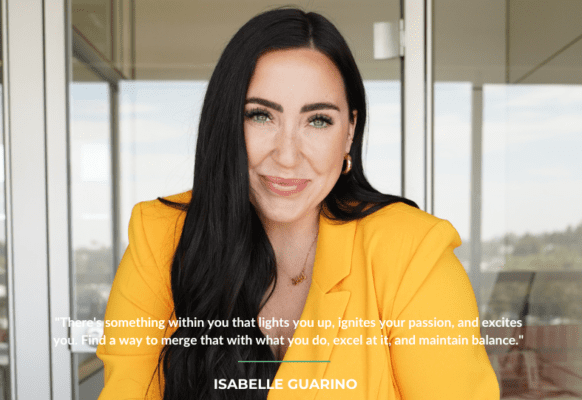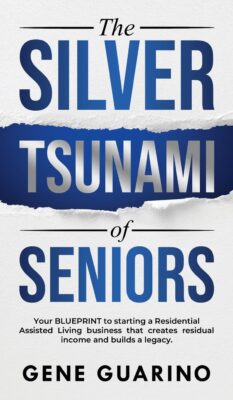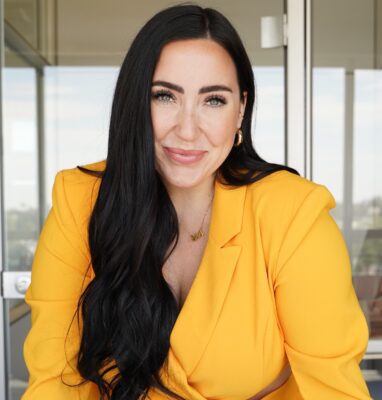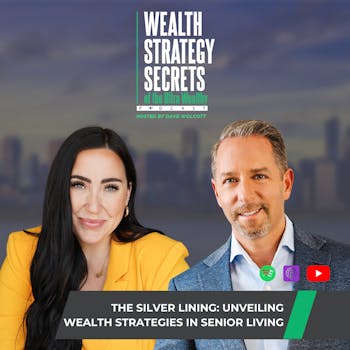Listen Here
 Today, we’re diving deep into the world of senior housing and assisted living with none other than Isabelle Guarino, the COO of Residential Assisted Living Academy. For the past decade, Isabelle has been at the helm, ensuring smooth operations and keeping everyone on task.
Today, we’re diving deep into the world of senior housing and assisted living with none other than Isabelle Guarino, the COO of Residential Assisted Living Academy. For the past decade, Isabelle has been at the helm, ensuring smooth operations and keeping everyone on task.
Her expertise in senior housing has earned her recognition as one of the “Top Influencers in Senior Housing,” and she’s a two-time recipient of Aging Media’s prestigious “Future Leaders of Assisted Living” award.
In this episode, Isabelle shares invaluable insights into the booming senior housing industry, offering listeners a glimpse into the strategies and secrets that have propelled her to the top of her field.
She also delved into the key factors driving the success of Residential Assisted Living Academy and the broader Senior Housing market. She emphasized the importance of providing high-quality care and personalized services to residents, highlighting how these principles have been central to their company’s growth and reputation.
Tune in as we uncover the wealth-building opportunities hidden within senior living, and learn from the best in the business. This is an episode you won’t want to miss!
In This Episode
-
Her knowledge and expertise in Residential Assisted Living
-
The current markets and identification of emerging trends and demographics in senior housing
-
Understanding the potential for rental income and property appreciation in senior living facilities
-
Leveraging tax advantages specific to real estate investments in the senior housing sector
Welcome to today’s show on Wealth Strategy Secrets. Today, we are joined by Isabelle Guarino. Isabelle is an ASU graduate and is now the COO of Residential Assisted Living Academy. She served as the COO for over 10 years and has been recognized as one of the top influencers in Senior Housing. She also won the Aging Media Award – the “Future Leaders of Assisted Living”. And has also been honored as one of the few under 30 to make the future leaders list, both times. Isabelle, welcome to the show.
Thank you for having me, I’m excited to be here.
This is an interesting Asset Class that is often understated. People don’t realize that there are investment opportunities and this is a great asset class inside of Real Estate that people should be looking to add to their portfolio. I’m excited to have you today and help investors learn more about Residential Assisted Living. How does that work? What is the business model? Kick us off.
I love it. It is something that everyone should have in their portfolio. Even if you’re doing a million things, it’s important to have a plan if and when you or a loved one needs care and assistance. Because, oftentimes, people think, “I don’t want to put my loved one into a home, but what am I gonna do? I can’t quit my job and take care of them full-time.” Or maybe that’s not their calling in life to be that full-time caregiver.
The reality is, gravity works the same at a senior home as it does at your home.
Having one of these in your portfolio is a great opportunity to not only cashflow, but potentially use some Real estate you already have that isn’t performing as well, and have a place for a loved one if and when they need it. That’s how we got started. My grandmother needed care; my family was searching for an option for her, and we stumbled into this. We realized that facilities were not the way to go. The care is subpar, the food is disgusting, and they’re expensive with waiting lists.
We wanted an alternative. So we discovered Residential Assisted Living, which currently is being run almost 80% by immigrants – people from other countries who’ve come over, do it all themselves, live in the home, work in the home, and care for the seniors. We wanted to run it more as business professionals, as a passive Real estate investment opportunity.
We revamped what was already happening and put our spin on it. After 10 years in the business, I have loved every year of it because it’s amazing that it’s growing and it’s becoming a new hot trend in Real estate investing. I love to see all the different ways and avenues people are getting involved these days.

Interesting. Tell us about the Macroeconomic fundamentals, I know they call it the ‘Silver Tsunami’ now. With boomers retiring every day – a massive amount. But what does that look like in the Assisted Living facilities?
Currently, the silent generation lives in Assisted Living and there are about 47 million of them. However, the 76 million baby boomers will be entering the assisted living market in the next 10 to 20 years. Currently, they’re building about 50,000 beds per year. That’s the projected amount of additional beds being built, but we are already 1.3 million beds short. With almost doubling the amount of seniors who are going to need this, we can’t build these beds fast enough.
There is an absolute total discrepancy between the supply and demand. When we talk about the Silver Tsunami, it’s not like something that’s happening, something that’s going to come. It’s going to completely impact all markets. The baby boomers have been driving our economy for the last 70-plus years.
This is only going to keep going and seriously impact the housing market, the care market, and medical. It’s going to have a huge impact. It could either be one of the biggest crises that our world; it was the world war that set off the baby boomers – our world, our country, our community, or your family could ever face, or it could be one of the biggest opportunities.
It’s like having a crystal ball back in 2008. We can see what is coming. We know what is ahead. The numbers don’t lie. It’s right there. There’s a lot of people saying, “I wonder what’s going to happen.” And we’re sitting here saying, “We’re ready to ride this wave. We’re excited for it.”
It’s coming. We like to invest where we’re aligned with the macro fundamentals because then, you can position yourself through the different cycles. Are there any particular markets, per se, that you’re seeing? We usually think of places like Florida, where I am right now, that are probably big markets for that. But do you focus on any particular markets?
We teach national standards. I’m based in Arizona, so much like Florida. We’ve got an influx of these that already exist here. I tell people all the time, “Raise your hand if you’re getting older or know someone who is. If you lived in Boston your whole life, you’re not going to move to Florida because you turned 85. If that’s where you lived and grew up and you’ve done your thing there, you’re going to stay there or stay near your adult children.”
That is typically who is searching for the care for mom or dad and paying for the care oftentimes as well. It’s important to remember people are aging everywhere, and there’s a need everywhere. In certain states like Arizona, Washington, Florida, and Texas, it may be easier to get the home up and running because there are already many of these that exist. The rules are laid out.
Now my competition is a lot steeper. Here in Arizona, in one county, Maricopa County, there are over 3,000 group homes. Like our competition, you could drive down the street that my home’s on and there’s another one. What makes someone want to choose me over the four other options if they’re going to offer them $200 less? It may be easier to get it up in a market like Florida or Arizona, but our competition is steep.
Now we go to a different market – Delaware, Rhode Island, Wyoming, where there is little to none of these, and it may be a lot more difficult to get it up and running, but you’re one of one. You have a waiting list out the door because there are not a lot of options, and the big boxes are full. They need more care, they need more options, and the cost to live in those homes is steep because there are not many options.
I always tell people that you need to pick and choose your battles. Easier to get up, and harder to maintain for 10 or 20 years of running the business. Or harder to get up, but easy to maintain in a sense.
Good point. Tell us how the business model works. Do you own one specific unit? Are you going in with a group of investors? How does it work?
We typically teach people how to own the Real estate and operate the business. That’s what we do and what most of our students do. That’s because you can control the most in that sense and you also can cash flow the most. This does not mean you’re living in the home or working in the home. I spend about five hours a week on my three properties and that’s what we show people how to do to get to that more passive hands-off investor standpoint.

Even if you’re doing a million things, it’s important to have a plan for when you or a loved one needs care and assistance.
You can use your own money to get started, although we don’t recommend it. SBA loves to lend on this. SBA 7(a) loans are comfortable and familiar with Residential Assisted Living homes. With bank loans – you can use private money or hard-earned money. Some people use IRA money, and a lot of other people do syndications for this. You can work with other investors or partners and bundle up a package right there – raise that capital, and go get started on the project. But it comes down to two key parts – the Real estate and the business side of it.
What is the average size of one of these units? Are you talking about the $10 million property or the $40 million property, or do you have all different types of ranges?
Great question. We focus on residential assisted living. These are all zoned residential, and they’re in single-family neighborhoods & communities. Our homes were limited to 10 residents in a home here in Arizona. Depending on where you are across the country, it’s going to range somewhere between six and sixteen.
In Florida for you, it’s twelve. You’re allowed to have twelve residents in a home. Your state will give you a rule, and it’s typically around 80 to 100 square feet per person. That is cruel, that is way too small, and it should be illegal, but it’s not. Our rule of thumb is 300 to 500 square feet per resident.
With ten residents, a minimum of 3,000 up to 5,000 square foot home is comfortable. I know finding a 10 or 12-bed home on the market is nearly impossible unless we’re looking at 50-cent homes in Connecticut that don’t exist often.
You’re buying something that’s maybe a 6 to 5 and it’s already 4,500 square feet. We’re chopping up the home differently – adding more bedrooms and bathrooms, maybe converting a garage, or doing an addition. These homes aren’t massive. They’re not commercial, they’re not facilities – they’re single-family residential neighborhood homes. But they’re being used differently instead of mom, dad, two kids, and a dog. It’s ten seniors and 24/7 care.
Interesting. The entry point into this is, let’s say, you buy a property for 500K. Maybe you’re doing a hundred 200K of renovations to get it operationally ready. This is something an investor can set up as a side hustle or an alternative way to create passive income.
Absolutely. The cost of entry is going to depend on where you are in the country. Someone in Oklahoma is going to have different numbers than someone in San Jose, California. It is tough to put a dollar amount on it. We’ve had investments as low as $300K and others upwards of $3 million. It varies. It depends on which of the four routes you choose to get started. What we’re talking about right now is a single-family home being converted.
Another option is buying an existing home. We talked about how many of these exist right now and you could purchase one that’s already up and running, the Real estate, the business – your cash flowing day one. Third, you could lease a home to use for this. Some investors are already getting homes ready and primed for this – adding more bedrooms and bathrooms, fire suppression, and sprinklers. You could lease a home to use for this to operate the business. Fourth, you could buy land to build custom from the ground up. All four of those have different timelines and price points, but many options on how you can get involved.
Are you seeing one of those options as more successful than the other?
I feel like a lawyer if I say it depends, but it does depend on your market. When you’re like us, in Florida or Arizona, there are a lot of these homes that are potentially for sale. But if we’re in South Dakota, you might not have any for sale.
If you’re allowed to have more than 12 residents, I highly recommend a ground-up custom build because it’s tough to take a home that already exists and chop it up that way. It does make a lot of sense to do a ground-up build when you’re having that 12 to 16 residents. And the home is perfectly suitable for this. It’s custom built and it’s spectacular.
How about from a regulatory standpoint? Are there certain permits that you have to have and building to spec, or even if you’re renovating? I could imagine the plumbing that you would have to do to all of a sudden move to 10 units in a place. Then also for seniors, in terms of walkability, you can’t have a two-storey, three-storey thing. Or if you do, how does that work?
Pick and choose your battles: it’s often easier to start something but harder to sustain it for 10 or 20 years, or it may be harder to begin but easier to maintain in the long run.
The state will have certain regulations on the physical properties. Points of egress, ramps, guardrails, handrails, and fire suppression are required in some states, and so are sprinkler systems. You’re going to want to make sure that either the sewer or the septic can withstand that many residents within the home. You may need to widen water pipes, put in a water tank, and do all sorts of different things depending on the home and where it’s located.
As you mentioned, if it’s a multi-storey home, we don’t say that you can’t do that, but you’re going to need to add a chair lift or a residential elevator. All of these things can add up to the cost of the property and getting it suited for this. Now, you don’t have to be ADA (Americans with Disabilities Act) compliant, but you want to be as close to that as possible to give the seniors a seamless experience and make sure that they’re safe.
Because the reality is, that gravity works the same at their home and your home. We want to have the least amount of trips, falls, and hazardous things within the home. We want to make it suitable for them so that they can have a nice experience. All of those things add to the bottom line. Once you’ve done those renovations, that’s when the state or the Fire marshal comes in to give you that stamp of approval and the license on the physical home.
The other two licenses that will be required are the license for the administrator. This is the person who works in the home day to day, doing the hiring and the firing of your caregivers, doing the marketing to fill the beds, doing the tours with the families, and doing that intake.
Then they’re maintaining those policies and procedures that you’ve set out as the business owner so that the business is running on a good, healthy day-to-day basis. It’s similar to a property manager in real estate terms. The third license is for the caregivers, but you technically don’t have a license – it’s the home, the administrator, and the caregivers.
My next question is, from an operational perspective in terms of running as a business, I can see that you’ve got two parallels to this. You’ve got the real estate itself, and then you’ve got running the business. How have you found that? Is this something someone can do passively?
Because we have a lot of passive investors. We know that time is one of our most important assets and we’re looking to scale our wealth. But is this an easy business to manage? Can you do that passively, or does it get quite comprehensive?
There are many ways you can get involved. One, could be owning the real estate and leasing it to a company that’s going to run this business within your home. In that sense, it is relatively hands-off because you’re doing that work upfront, getting the property ready to go, and then maybe having a contract with them that’s similar to a five or eight-year leasing contract, where they’re paying you twice the fair market rent to run the business within the home.
They’re willing to pay you that extra because you’ve done all the work of getting it ready to go for that stamp of approval with the license. That’s one way that you can passively get involved in this on the Real estate side. The most passive is to be a private lender or JV (Joint Venture) partner on one of these deals. Being that money piece and investing in someone who’s going to do this business. There’s a lot of need for that.

It’s going to impact all of our lives, whether it’s a loved one who needs it or you one day needing it yourself. Aim to provide a blessing, not a burden, for your children.
I speak with investors every day who say, “I don’t want to own the Real estate. I don’t want to own the business, but I do want to invest in someone”. The third and most hands-on part would be owning the Real estate and operating the business. This is what I do, and what I was sharing is that I’m now down to working five hours a week. In the beginning, it was not five hours a week. We had to get those systems up. I had to get the administrator trained. We had to build our brands and our reputation.
But a year and a half in, we’re down to ten hours. Two years in, I’m down to five hours. That’s passive for me. I’m running eight other businesses and those that I get to my check and make my phone call every month. It can get there. That’s what we show investors how to do, but that work upfront has to happen. I’ll never say that this is easy. There are much easier ways to make money in real estate.
The reason that the rewards are high is because it does take some work to get up and running. There are rules, regulations, and licensing, and people’s lives are at stake. It is important to make sure to go about it in the right way and also know yourself. Know how involved you want to be.
What do the average return profiles look like? Just from a ballpark standpoint, I know there are many configurations.
It could be 12 to 15 percent. It depends on that unique and individual deal on what the operator is willing to give up for that money.
Are there many people out there doing this as a fix-and-flip model as well? Where they’re turning them in.
We do have a student who has focused on that. They take the homes, buy existing homes, make them better, then repackage and sell them. That is a way you could do that. The cool thing is that you’re thinking of all these creative ways to do it.
You’re starting to see more and more of these opportunities and everyone has their unique perspective on how they can get involved. I’m loving it. I love that everyone comes with their unique situations and how we can continue to improve this. You could do fix and flip, for sure.
Frankly, what’s cool about Real estate is you can be creative. I love that this is accessible. We primarily deal with accredited investors, and it’s harder to find good opportunities for non-accredited. Even my kids in their twenties, they’re anxious to get into investing which is the right opportunity for them.
But this is something that they could get into. As you said, you could get SBA financing and not much money down to get into a business. You could put some sweat equity into this thing and get it running. Then to the point where you work a couple of hours a week, that is a fast way to build up your balance sheet and cash flow as well.
Absolutely. For me, it’s also that other side, which we don’t often talk about when we’re talking about investment. I mentioned in the beginning, that everyone’s going to deal with assisted living one way or another. It’s going to impact all of our lives, whether it’s a loved one who’s going to need this, whether you one day need it and you don’t want to leave your kids a burden, but instead a blessing.
Find what speaks to your heart and your soul.
My father and I started this business ten years ago when my grandmother needed care, as I shared. When he passed, his three businesses got passed to me, one generation to the next, which we all know is a 70% fail rate for businesses passing to the next generation. We’ve been going strong for the last two years since he’s been gone, and that’s amazing. Not only having an opportunity for my loved ones if they need it but being able to pass this on from generation to generation, a cash-flowing business that’s relatively hands-off, that’s cool. I’m excited to be able to give that to my son one day.
I love that. Having some purpose and passion in your investments that are doing a greater good. That is the icing on the cake of all the other benefits of Real estate. How about from a tax perspective? Are you doing cost segregation studies on these properties also?
We do work with some companies that do that on these properties – that is a way that you can go about this. We have amazing partnerships with Prime Corporate Services and different cost segregation companies that work with our students. There are some tax breaks and some amazing opportunities in that regard.
Have you built any of these in opportunity zones as well? Have you looked at that?
No, not right now. We typically focus on wealthier areas. You’re looking for what we call the ‘Daughter Judy’, which is our 50 to a 70-year-old adult child. They’re the ones that we talked about who are looking for the care and determining where the care is.
We want where the 50 to 70-year-olds who are making upper middle or who are upper middle class making twice the median income – typically college grads, and homeowners. We’re targeting them and their specific areas. That’s the target market or demographics you’re looking at.
That makes a lot of sense because they’re the ones searching for the care and doing all the management for their parents.
They can afford the high rates. It’s expensive to go into assisted living.
We visited my mother-in-law up in Upstate New York, who’s 99 right now, which is amazing. But she’s in a facility there because they’ve lived there their whole life. It’s preposterous what the fees are and what she’s getting for that.
That’s where we’re from, Upstate New York, and that’s exactly what we found with my grandmother. I thought, “This is insane.”

Ask yourself how you can help others while also doing good for yourself. When you achieve that balance, you live in true fulfillment, embracing what you value every day and what excites you.
It is crazy. I applaud your efforts in trying to make better communities for seniors and help them. Because the challenge is twofold. If you are a senior, you’re at that point where it’s challenging to figure out a solution. You’re relying upon those to your older children to do that. They’re busy raising their kids, how do you find the right solutions? And as you say, there are not that many beds, not that many options in a particular area.
We’ve even talked to her for instance, about coming down to Florida where, “Maybe there’s better weather. You’d have better facilities. You’d have a courtyard. You could go out.” And she doesn’t even want to change her location. Because they’re set in their ways and they’re tied to memories. It would be disruptive to move them at that point. That’s cool that you can go into a community and then provide a solution for them there.
We need more and more honesty, and there’s such a need. When we talk about the cost of care, you have a loved one who’s experiencing this so you’re familiar with what’s available and the cost of it. But people who don’t; maybe who are listening and who haven’t experienced this yet. Thinking, “What’s even included or what does this look like?”
Until it hits you until it happens, then you’ll say, “This is a huge opportunity.” We say senior housing is like a ripe avocado, it’s ready to go for three days – then it’s brown and mushy. When you need assisted living, it’s not something that you’ll think, “Mom is going to need it in about a year from now.” It’s typically like, “They’re fine. Something happens, and they need it now.” But then, it will be too late.
So you have to have a plan and if you don’t, that’s why it’s nice for me to have these in my portfolio. When I have a loved one, I could simply say, “Okay, let’s get you in. Let’s make it happen.” I’m saving that money so that I don’t have to pay for them to go be in a facility because they get to live for free in mine while I’m cash-flowing. That’s cool.
Tell us about your model at the Assisted Living Academy. You guys are training people how to do this?
Exactly. We show people how to purchase and renovate real estate or ground build whatever they want to do or buy a business. We go through all four of the methods. We’re then showing you how to get your license staff, and how to get licensed through the state. If you’re going to do memory care, we go through all of that – how to raise the capital, create your business plan and Pro Forma, then run the numbers.
We even take people by my homes and show them other student’s homes across the country. We’ve been in the business for the last ten years. We’ve got a lot of successful students who’ve opened homes all across the country. We’re not a franchise, so I don’t own theirs or take any piece of them. I show people how to do what I do so that they can do it and cashflow for the rest of their lives.
Everyone who teaches and trains with me was a past student who was in the class, who went out, got their homes up and running, and now they’re back to keep the message going forward of how to do well with Residential Assisted Living.
Awesome. Isabelle, if you could give one piece of advice to our listeners about how they could accelerate their wealth trajectory, what would it be?
Get excited and pursue something that speaks to your heart.
Totally outside of RAL, but find what speaks to your heart and your soul. I believe we were all put on the earth with something inside of us – whether that’s helping dogs, helping seniors, or helping children. There’s something in you that lights you up, gets you passionate, and gets excited. Find a way to merge that, do well, and have that balance.
Ask yourself, how you can help someone else, but also do good for yourself in the meantime. When you do that, you’re living in true fulfillment because you’re living with what you value every day and what makes you excited. There are too many of us who are drifting by and it’s the same old, don’t do that. Get excited and do something that your heart speaks to.
Good advice. Life is short, and before you know it, you’ll be in one of those centers as well. You’ve got to seize the day. This has been an enlightening conversation, Isabelle. It’s an interesting asset class.
I love the creative way to build some passive income and diversify from the Stock Market. It also aligns with macroeconomic fundamentals. If people would like to learn more about your academy and how this works, what’s the best place?
Check out RAL101.com. We’ve got free webinars and books. You can schedule a phone call with me or the team there. You can find us on any social media – Facebook, Instagram, TikTok, you name it @RALacademy.
Awesome. I appreciate it, Isabelle.
Thank you for having me.
Thank you again for tuning in this week. If you’re enjoying the show and would like to learn more, please go ahead and subscribe and rate the show so we can have more great guests like Isabelle on the show. Until next week, thanks.
Important Links
Connect with Isabelle Guarino
Connect with Pantheon Investments
Further Resources
Your 10-Step Actionable Checklist From This Episode
✅ Learn how Residential Assisted Living (RAL) works, including owning the real estate and operating the business, to maximize control and cash flow.
✅ Choose a location based on market needs, competition, and ease of setting up RAL homes. Consider less saturated markets for easier entry and potential growth.
✅ Decide whether to purchase an existing home, convert a single-family home, lease a prepared property, or build a custom home from the ground up.
✅ Modify the property to meet the requirements for assisted living, including space per resident, accessibility, and safety enhancements.
✅ Establish a plan for ongoing management, whether through leasing or direct operation, to ensure sustainable and profitable investment over the long term.
✅ Determine how hands-on you want to be in the business. Whether you prefer to own and operate or just invest, know your limits and commitment level.
✅ Work with companies that specialize in cost segregation studies to maximize tax benefits. Consider forming partnerships with firms that offer these services to your students or clients.
✅ Build your business with future generations in mind. Create a model that can be passed down and continue generating income with minimal hands-on involvement.
✅ Choose a business model that resonates with your values and passion. This alignment will keep you motivated and fulfilled in the long term.
✅ Continuously educate yourself and your team through webinars, books, and training programs. Engage with industry experts and resources like the RAL Academy to stay ahead.
About Isabelle Guarino
 Isabelle is a graduate of Arizona State University, a former flight attendant, a Walt Disney World intern, and now Residential Assisted Living Academy’s leading lady. She has been working as the COO of the company for the last 10 years, keeping everyone in line and on task. She’s been featured in many magazines and articles on the topic of Senior Housing and most recently was given the title of one of the “Top Influencers in Senior Housing”. Isabelle also won Aging Media’s “Future Leaders of Assisted Living” award twice in 2020 and 2024 being 2 of 100’s under 30 to make the list.
Isabelle is a graduate of Arizona State University, a former flight attendant, a Walt Disney World intern, and now Residential Assisted Living Academy’s leading lady. She has been working as the COO of the company for the last 10 years, keeping everyone in line and on task. She’s been featured in many magazines and articles on the topic of Senior Housing and most recently was given the title of one of the “Top Influencers in Senior Housing”. Isabelle also won Aging Media’s “Future Leaders of Assisted Living” award twice in 2020 and 2024 being 2 of 100’s under 30 to make the list.

